Papers by Mahmoud Elmaghrabey
Microchemical Journal, 2019
Integrative physicochemical and HPLC assessment studies for the inclusion of lornoxicam in buffal... more Integrative physicochemical and HPLC assessment studies for the inclusion of lornoxicam in buffalo's milk fat globules as a potential carrier delivery system for lipophilic drugs,
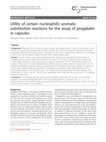
Chemistry Central Journal, 2011
Background: Pregabalin (PG) is an anticonvulsant, analgesic and anxiolytic drug. A survey of the ... more Background: Pregabalin (PG) is an anticonvulsant, analgesic and anxiolytic drug. A survey of the literature reveals that all the reported spectrophotometric methods are either don't offer high sensitivity, need tedious extraction procedures, recommend the measurement of absorbance in the near UV region where interference most probably occurs and/or use non specific reagent that don't offer suitable linearity range. Results: Two new sensitive and simple spectrophotometric methods were developed for determination of pregabalin (PG) in capsules. Method (I) is based on the reaction of PG with 1,2-naphthoquinone-4-sulphonate sodium (NQS), yielding an orange colored product that was measured at 473 nm. Method (II) is based on the reaction of the drug with 2,4-dinitrofluorobenzene (DNFB) producing a yellow product measured at 373 nm. The different experimental parameters affecting the development and stability of the reaction product in methods (I) and (II) were carefully studied and optimized. The absorbance-concentration plots were rectilinear over the concentration ranges of 2-25 and 0.5-8 μg mL-1 for methods (I) and (II) respectively. The lower detection limits (LOD) were 0.15 and 0.13 μg mL-1 and the lower quantitation limits (LOQ) were 0.46 and 0.4 μg mL-1 for methods (I) and (II) respectively. Conclusion: The developed methods were successfully applied to the analysis of the drug in its commercial capsules. The mean percentage recoveries of PG in its capsule were 99.11 ± 0.98 and 100.11 ± 1.2 (n = 3). Statistical analysis of the results revealed good agreement with those given by the comparison method. Proposals of the reaction pathways were postulated.

Methods and Applications in Fluorescence
A green, one-pot, quick, and easily synthesized nitrogen and sulfur co-doped carbon quantum dots ... more A green, one-pot, quick, and easily synthesized nitrogen and sulfur co-doped carbon quantum dots (N,S-CDs) were obtained from cheap and readily available chemicals (sucrose, urea, and thiourea) using a microwave-assisted approach in about 4 min and utilized as a turn-off fluorescent sensor for estimation of natamycin (NAT). First, the effect of N and S doping on the microwave-synthesized CDs' quantum yield was carefully studied. CDs derived from sucrose alone failed to produce a high quantum yield; then, to increase the quantum yield, doping with heteroatoms was carried out using either urea or thiourea. A slight increase in quantum yield was observed upon using thiourea with sucrose, while an obvious enhancement of quantum yield was obtained when urea was used instead of thiourea. Surprisingly, using a combination of urea and thiourea together results in N,S-CDs with the highest quantum yield (53.5%), uniform and small particle size distribution, and extended stability. The flu...

Journal of Pharmaceutical and Biomedical Analysis
α-Dicarbonyl compounds (α-DCs) are very clinically important as they are considered as advanced g... more α-Dicarbonyl compounds (α-DCs) are very clinically important as they are considered as advanced glycation end products (AGEs) precursors and biomarkers for many chronic diseases such as diabetes and vascular diseases, in addition to their major role in progression of complications of such diseases. Aromatic aldehydes and ammonium acetate were productively used as a one-pot co-reagents for fluorogenic derivatization of α-DCs yielding fluorescent imidazole derivatives. Among the tried aromatic aldehydes, 4-carbomethoxybenzaldehyde yielded the products with best fluorescent characters. This approach for fluorogenic derivatization of α-DCs overcome the selectivity problem of the most commonly used derivatization reagent for α-DCs, α-diamino compounds, that can react unselectively with α-DCs and aldehydes. Separation of the formed imidazole derivatives of five α-DCs including glucosone, 3-deoxyglucosone, glyoxal, methyl glyoxal and dimethyl glyoxal together with ethylmethylglyoxal as an internal standard was carried out on an octyl column using a mobile phase consisted of methanol-water (15:85, v/v%) containing 0.2% formic acid with time programed flow, followed by fluorescence detection at excitation/emission wavelengths of 310/410 nm. The method showed excellent sensitivity for the targeted α-DCs with limits of detections ranging from 0.4 to 5.0 nM in human serum. Simple protein precipitation procedure was used for human serum treatment yielding very good recovery (91–105%) for the targeted α-DCs. The developed method was fully validated, then applied to the analysis of the five above mentioned clinically important α-DCs in serum samples of healthy, diabetic, rheumatic and cardiac disorders human volunteers. Due to the excellent analytical features of the developed method, including high selectivity and sensitivity, it was able to detect the pattern of the targeted α-DCs serum levels under the investigated different clinical conditions.
Journal of Liquid Chromatography & Related Technologies
A simple, sensitive, and rapid HPLC method was developed and validated for the simultaneous deter... more A simple, sensitive, and rapid HPLC method was developed and validated for the simultaneous determination of metoclopramide hydrochloride (MCA) and pyridoxine hydrochloride (PDX). The analysis was carried out on CLC Shim-pack C8 column (250 × 4.6 mm, 5 µm particle size) using a mobile phase consisting of methanol: 0.02 M phosphate buffer mixture (45: 55, v/v) of pH 3.0. The mobile phase was pumped at
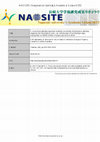
Talanta
Pre-column derivatization with fluorescence labeling reagents involves many problems including cr... more Pre-column derivatization with fluorescence labeling reagents involves many problems including crowded chromatograms, possibility of the introduction of analytical errors, and poor selectivity. Here in we report a novel purification tag/fluorophore dual labeling approach based on a multi-component reaction to solve this major problem. Glyoxylic acid was recently identified as an early biomarker for diabetes, thus it was selected as a model analyte for our new dual labeling approach. Using the multi-component Petasis reaction, we could introduce a fluorophore (1-pyreneboronic acid, 1-PyBA) and a purification tag (taurine) to our target analyte (glyoxylic acid) in one step reaction. Using taurine as the amine reactant in Petasis reaction leads to the formation of a reaction product with a terminal sulfonic acid group which can be selectively retained on an anion exchange sorbent allowing excess fluorescent 1-PyBA reagent and its fluorescent decomposition products to be washed away. Then, quantification of the formed analyte-fluorophore-purification tag adduct was carried out by a simple isocratic HPLC-fluorescence detection method. The newly developed technique allowed highly selective, very rapid and efficient determination of glyoxylic acid in human serum eliminating endogenous components and excess reagent interference. Glyoxylic acid was determined in serum at a final concentration down to 30 nM (600 fmol/injection) with good recovery (87.0%), accuracy (-2.2-9.2) and precision (%RSD ≤8.7).

Journal of Chromatography A
9,10-Phenanthrenequinone (PQ) was successfully used as a new mass-tagging reagent for sensitively... more 9,10-Phenanthrenequinone (PQ) was successfully used as a new mass-tagging reagent for sensitively labeling aliphatic aldehydes (C3-C10) prior liquid chromatography-electrospray ionization tandem mass spectrometry (LC/ESI-MS/MS). This reagent could overcome the drawbacks of previous amine or hydrazine-based reagents, such as lower sensitivity, formation of two stereoisomeric reaction products for each single analyte, need for longer derivatization time, and poor reactivity with aliphatic aldehydes. The PQ-aldehyde derivatives exhibited intense [M+H] + and a common product ion with ESI in the positive-ion mode. The derivatives were monitored at the transition of [M+H] + → m/z 231.9 with detection limits from 4.0 to 100 pM (signal to noise ratio = 3). 3-Phenylpropanal was used as an internal standard (IS) and the separation of the eight aldehydes and IS was achieved in less than 10 min employing gradient elution with methanol and ammonium formate buffer (20 mM, pH 4.0). The method employed salting out liquid-liquid extraction for aliphatic aldehydes form serum for the first time with excellent recoveries (92.6-110.8%). The developed method was validated and applied for quantification of the target aldehydes in serum of healthy volunteers (n=14).
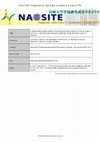
Journal of Pharmaceutical and Biomedical Analysis
A fast, accurate, and ultrasensitive high-performance liquid chromatography method with chemilumi... more A fast, accurate, and ultrasensitive high-performance liquid chromatography method with chemiluminescence detection (HPLC-CL) was optimized and validated for the determination of pyrroloquinoline quinone (PQQ) concentration in human plasma following solid-phase extraction (SPE). This method is based on the redox cycle of the reaction between PQQ and dithiothreitol, which generates reactive oxygen species that can be detected using luminol as a CL probe. The isocratic HPLC system comprised an ODS column and 4.0 mM tetra-n-butylammonium bromide in Tris-HNO3 buffer (pH 8.8; 50 mM)-acetonitrile (7:3, v/v) as mobile phase. A novel, rapid, and simple SPE method was also developed providing excellent %recovery (≥95.2%) for PQQ from human plasma samples. The proposed method was linear over the range of 4.0-400 nmol/L plasma of PQQ with a lower detection limit (S/N = 3) of 1.08 nmol/L plasma (0.27 nM). The method was successfully implemented to determine PQQ concentration in the plasma of healthy individuals after administration of PQQ supplements.

Analytical biochemistry, 2014
A validated, simple and sensitive HPLC method was developed for the simultaneous determination of... more A validated, simple and sensitive HPLC method was developed for the simultaneous determination of lipoperoxidation relevant reactive aldehydes: glyoxal (GO), acrolein (ACR), malondialdehyde (MDA), and 4-hydroxy-2-nonenal (HNE) in human serum. The studied aldehydes were reacted with 2,2'-furil to form fluorescent difurylimidazole derivatives that were separated on a C18 column using gradient elution and fluorescence detection at excitation and emission wavelengths of 250 and 355nm, respectively. The method showed good linearity over the concentration ranges of 0.100-5.00, 0.200-10.0, 0.200-40.0, and 0.400-10.0nmol/mL for GO, ACR, HNE, and MDA, respectively, with detection limits ranging from 0.030 to 0.11nmol/mL. The percentage RSD of intraday and interday precision did not exceed 5.0 and 6.2%, respectively, and the accuracy (%found) ranged from 95.5 to 103%. The proposed method was applied for monitoring the four aldehydes in sera of healthy, diabetic, and rheumatic human subjec...

European Journal of Drug Metabolism and Pharmacokinetics, 1999
Semicarbazide-sensitive amine oxidase (SSAO) is present in the plasma membrane of several human t... more Semicarbazide-sensitive amine oxidase (SSAO) is present in the plasma membrane of several human tissues, e.g. vascular smooth muscle cell adipocytes, and is also found in human serum. Some previous studies on cultured endothelial cells indicate that cytotoxic metabolites (e.g. hydrogen peroxide, formaldehyde, acrolein) formed by serum SSAO may cause endothelial injury and subsequently induce atherosclerosis. To investigate the role of this enzyme in the pathogenesis of macrovascular complications in diabetes, a simple and sensitive radiometric procedure was adapted for human serum measurements. Serum SSAO activity of 35 patients with noninsulin dependent diabetes mellitus (NIDDM) and that of 30 controls was determined using [14C]-benzylarnine as substrate. The severity of atherosclerosis was assessed by carotid sonography. Diabetic patients with atherosclerosis exhibited a higher SSAO activity compared to diabetic patients without complications (212.91 ± 90.54 pmol/mg protein/h versus 133.17 ± 65.40 pmoUmg protein/h, P <0.04). In diabetic patients without complications, serum SSAO activity was elevated compared to control subjects (133.17 ± 65.40 pmol/mg protein/h versus 91.79 ± 31.70 pmol/mg protein/h, P <0.01). These results suggest that determination of human serum SSAO activity might be a usefulmarker in the prognostic evaluation of diabetic angiopathy and atherosclerosis.
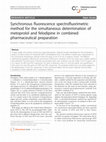
Chemistry Central Journal, 2011
A rapid, simple and sensitive synchronous specrtofluorimetric method has been developed for the s... more A rapid, simple and sensitive synchronous specrtofluorimetric method has been developed for the simultaneous analysis of binary mixture of metoprolol (MTP) and felodipine (FDP). The method is based upon measurement of the synchronous fluorescence intensity of the two drugs at Δλ of 70 nm in aqueous solution. The different experimental parameters affecting the synchronous fluorescence intensities of the two drugs were carefully studied and optimized. The fluorescence intensity-concentration plots were rectilinear over the ranges of 0.5-10 μg/mL and 0.2-2 μg/mL for MTP and FDP, respectively. The limits of detection were 0.11 and 0.02 μg/mL and quantification limits were 0.32 and 0.06 μg/mL for MTP and FDP, respectively. The proposed method was successfully applied for the determination of the two compounds in their commercial tablets and the results obtained were favorably compared to those obtained with a comparison method.
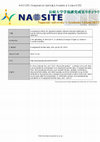
Analytical Biochemistry
A validated, simple and sensitive HPLC method was developed for the simultaneous determination of... more A validated, simple and sensitive HPLC method was developed for the simultaneous determination of lipoperoxidation relevant reactive aldehydes: glyoxal (GO), acrolein (ACR), malondialdehyde (MDA), and 4-hydroxy-2-nonenal (HNE) in human serum. The studied aldehydes were reacted with 2,2′-furil to form fluorescent difurylimidazole derivatives that were separated on a C18 column using gradient elution and fluorescence detection at excitation and emission wavelengths of 250 and 355 nm, respectively. The method showed good linearity over the concentration ranges of 0.100–5.00, 0.200–10.0, 0.200–40.0, and 0.400–10.0 nmol/mL for GO, ACR, HNE, and MDA, respectively, with detection limits ranging from 0.030 to 0.11 nmol/mL. The percentage RSD of intraday and interday precision did not exceed 5.0 and 6.2%, respectively, and the accuracy (%found) ranged from 95.5 to 103%. The proposed method was applied for monitoring the four aldehydes in sera of healthy, diabetic, and rheumatic human subject...






Uploads
Papers by Mahmoud Elmaghrabey